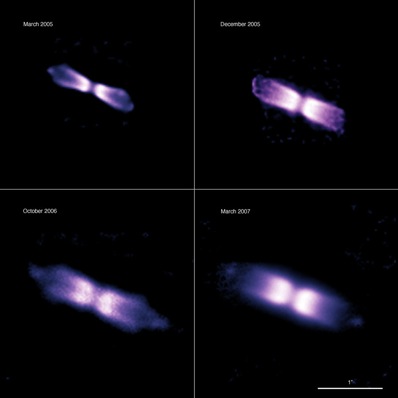



|

|

Vampire star prime candidate for Type Ia supernova
DR EMILY BALDWIN
ASTRONOMY NOW
Posted: November 17, 2009


Using ESO's Very Large Telescope, astronomers have made the first time-lapse movie of an unusual shell of material ejected by a 'vampire star' that is a prime candidate progenitor star of a Type Ia supernova.
 The NACO adaptive optics instrument on ESO's VLT allowed sharp images of the V445 Puppis system to be derived. The system is a prime candidate for a progenitor of Type Ia supernovae. Image: ESO/ P. A. Woudt. The NACO adaptive optics instrument on ESO's VLT allowed sharp images of the V445 Puppis system to be derived. The system is a prime candidate for a progenitor of Type Ia supernovae. Image: ESO/ P. A. Woudt.
In November 2000 V445 Puppis underwent an outburst after consuming some of its companion's matter and over a period of two years, ESO's VLT monitored this cannibalistic act, revealing some dramatic changes. Initially a bipolar shell with a narrow waist and lobes on each side is present. Two knots are seen at the extreme ends of the shell moving at some 30 million kilometres per hour, while the shell itself races through space at about 24 million miles per hour. Thick dust obscures the two central stars.
The double star is a prime contender to be a much sought-after progenitor of the breed of exploding star known as a Type Ia supernovae. “One of the major problems in modern astrophysics is the fact that we still do not know exactly what kinds of stellar system explode as a Type Ia supernova,” says Patrick Woudt, of the University of Cape Town and lead author of the paper reporting the results. “As these supernovae play a crucial role in showing that the Universe’s expansion is currently accelerating, pushed by a mysterious dark energy, it is rather embarrassing.”
|

|

|

|
|



